中医英语翻译理论与实践
中医实践英文作文模板

中医实践英文作文模板1. In my opinion, traditional Chinese medicine (TCM) isa valuable and effective approach to healthcare. TCM focuses on the balance of Qi, or vital energy, in the body, and aims to restore harmony and promote overall well-being.2. One of the key principles of TCM is the concept of Yin and Yang. This theory suggests that the body is composed of opposing forces that need to be in balance for optimal health. By identifying and addressing imbalances, TCM practitioners can help patients achieve better health outcomes.3. TCM also emphasizes the importance of individualized treatment. Unlike Western medicine, which often takes aone-size-fits-all approach, TCM practitioners consider a person's unique constitution, lifestyle, and environment when developing a treatment plan. This personalized approach can lead to more tailored and effective interventions.4. Another aspect of TCM that sets it apart from Western medicine is its use of natural remedies. TCMutilizes herbs, acupuncture, and other holistic therapies to promote healing. These natural treatments can be gentler on the body and have fewer side effects compared to pharmaceutical drugs.5. TCM also places a strong emphasis on prevention. Rather than waiting for symptoms to manifest, TCM encourages individuals to take proactive measures to maintain their health. This can include lifestyle modifications, such as dietary changes and stress management techniques, to prevent illness before it occurs.6. I believe that TCM can complement Western medicine and provide a more comprehensive approach to healthcare. By integrating the strengths of both systems, patients can benefit from a wider range of treatment options and achieve better overall health outcomes.7. However, it is important to note that TCM is not asubstitute for Western medicine in certain situations, such as emergencies or severe illnesses. In these cases, immediate medical intervention may be necessary. TCM should be seen as a complementary approach that can work alongside Western medicine to enhance overall well-being.8. In conclusion, TCM offers a unique perspective on healthcare and provides valuable insights into the holistic nature of the body. By considering factors such as balance, individuality, natural remedies, and prevention, TCM can contribute to a more comprehensive and personalized approach to healthcare.。
中医药名词英文翻译01(学科相关词汇)
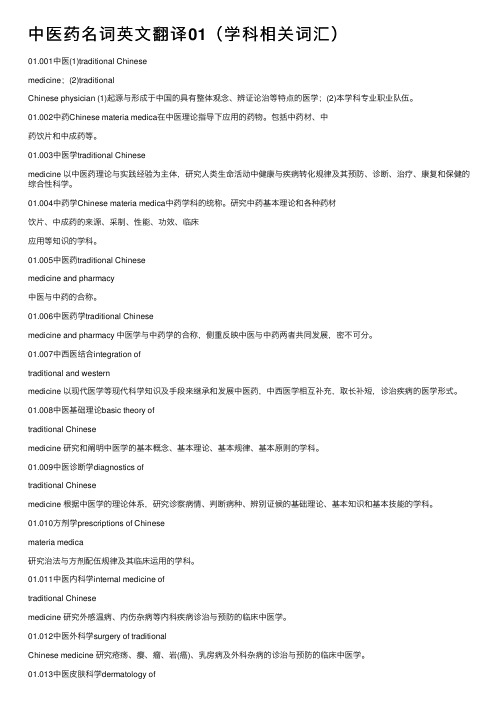
中医药名词英⽂翻译01(学科相关词汇)01.001中医(1)traditional Chinesemedicine;(2)traditionalChinese physician (1)起源与形成于中国的具有整体观念、辨证论治等特点的医学;(2)本学科专业职业队伍。
01.002中药Chinese materia medica在中医理论指导下应⽤的药物。
包括中药材、中药饮⽚和中成药等。
01.003中医学traditional Chinesemedicine 以中医药理论与实践经验为主体,研究⼈类⽣命活动中健康与疾病转化规律及其预防、诊断、治疗、康复和保健的综合性科学。
01.004中药学Chinese materia medica中药学科的统称。
研究中药基本理论和各种药材饮⽚、中成药的来源、采制、性能、功效、临床应⽤等知识的学科。
01.005中医药traditional Chinesemedicine and pharmacy中医与中药的合称。
01.006中医药学traditional Chinesemedicine and pharmacy 中医学与中药学的合称,侧重反映中医与中药两者共同发展,密不可分。
01.007中西医结合integration oftraditional and westernmedicine 以现代医学等现代科学知识及⼿段来继承和发展中医药,中西医学相互补充,取长补短,诊治疾病的医学形式。
01.008中医基础理论basic theory oftraditional Chinesemedicine 研究和阐明中医学的基本概念、基本理论、基本规律、基本原则的学科。
01.009中医诊断学diagnostics oftraditional Chinesemedicine 根据中医学的理论体系,研究诊察病情、判断病种、辨别证候的基础理论、基本知识和基本技能的学科。
01.010⽅剂学prescriptions of Chinesemateria medica研究治法与⽅剂配伍规律及其临床运⽤的学科。
[英语学习]翻译理论与实践
![[英语学习]翻译理论与实践](https://img.taocdn.com/s3/m/99dcc22e0912a216147929cd.png)
The definition is:
Translation is a rendering from one language into another, i.e., the faithful representation in one language of what is written or said in another language.
成都家教,成都家教网;
综合各家之长: (Sum Up)
• 翻译是把一种语言表达的意义用另一种 语言传达出来,以达到沟通思想情感、 传播文化知识、促进社会文明,特别是 推动译语文化兴旺昌盛的目的。 • Translation is an activity of reproducing in one language the ideas which have been expressed in another language.
推荐网站
1. 中国翻译协会
2. 传神社区
3. 众译网
4. 翻译中国
5. 正方翻译论坛
推荐期刊
1. 《中国翻译》 中国翻译协会 主办
2. 《上海翻译》
上海科技翻译学会 主办
成都家教,成都家教网;
课堂简报——《译文》
课堂简报——《译文》
成都家教,成都家教网;
Alexander Fraser Tytler:
• A good translation is one which the merit of the original work is so completely transfused into another language as to be as distinctly apprehended and as strongly felt by a native of the country to which that language belongs as it is by those who speak the language of the original work.
翻译理论在翻译实践中的应用与实践研究
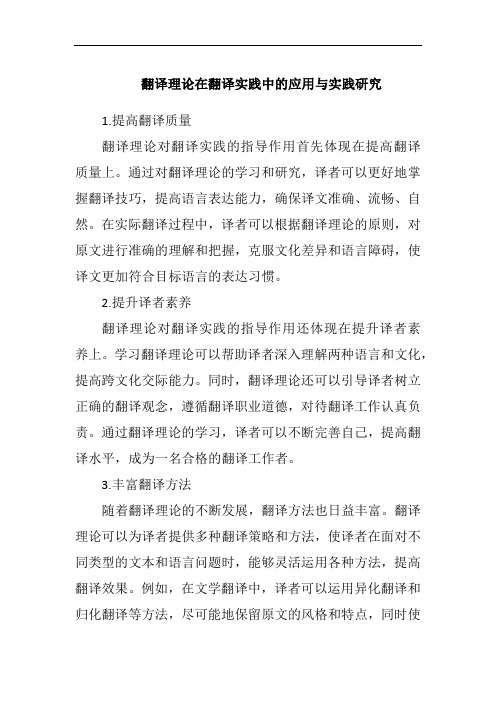
翻译理论在翻译实践中的应用与实践研究1.提高翻译质量翻译理论对翻译实践的指导作用首先体现在提高翻译质量上。
通过对翻译理论的学习和研究,译者可以更好地掌握翻译技巧,提高语言表达能力,确保译文准确、流畅、自然。
在实际翻译过程中,译者可以根据翻译理论的原则,对原文进行准确的理解和把握,克服文化差异和语言障碍,使译文更加符合目标语言的表达习惯。
2.提升译者素养翻译理论对翻译实践的指导作用还体现在提升译者素养上。
学习翻译理论可以帮助译者深入理解两种语言和文化,提高跨文化交际能力。
同时,翻译理论还可以引导译者树立正确的翻译观念,遵循翻译职业道德,对待翻译工作认真负责。
通过翻译理论的学习,译者可以不断完善自己,提高翻译水平,成为一名合格的翻译工作者。
3.丰富翻译方法随着翻译理论的不断发展,翻译方法也日益丰富。
翻译理论可以为译者提供多种翻译策略和方法,使译者在面对不同类型的文本和语言问题时,能够灵活运用各种方法,提高翻译效果。
例如,在文学翻译中,译者可以运用异化翻译和归化翻译等方法,尽可能地保留原文的风格和特点,同时使译文符合目标语言的表达习惯。
4.促进翻译评价体系的完善翻译理论对翻译实践的指导作用还可以体现在促进翻译评价体系的完善上。
翻译理论可以为译者提供评价译文质量的标准和方法,使译者在翻译过程中有据可依,提高翻译质量。
同时,翻译理论还可以帮助翻译评审者和读者更好地评价译文的质量,确保翻译工作的公平、公正、公开。
总之,翻译理论在翻译实践中的应用与实践研究具有重要意义。
翻译理论对翻译实践具有指导作用,可以提高翻译质量、提升译者素养、丰富翻译方法和促进翻译评价体系的完善。
因此,译者应当重视翻译理论的学习和研究,将翻译理论运用到实际翻译工作中,不断提高自己的翻译水平,为我国翻译事业的发展做出贡献。
同时,翻译理论研究者也应关注翻译实践,结合实际翻译问题,不断丰富和发展翻译理论,为翻译实践提供更有针对性和实用性的指导。
翻译理论与实践[汉译英]4.2谓语的确定与主谓一致问题1
![翻译理论与实践[汉译英]4.2谓语的确定与主谓一致问题1](https://img.taocdn.com/s3/m/7e4e375aa45177232f60a29d.png)
汉语隐性谓语的翻译
B. 名词性谓语 (nominal predicate )的翻译 例:今天星期五。 Today is Friday.
汉语隐性谓语的翻译
C. 数量词隐性谓语的翻译 例:她的未婚夫都60了。 Her fiancéis already 60 years old.
I 英汉语谓语的差异
?主语谓语系动词表语?主语谓语不及物动词?主语谓语及物动词宾语?主语谓语宾语宾语补足语?主语谓语间接宾语直接宾语在将句子译成英语时若主要成分的顺序一致则可套用对应的英语句型所选择的谓语也大致可以与原文对应
4.2谓语的确定与主谓一致问题
*汉语谓语(predicate)相对呈隐性,在表达 上具有多样性:谓语动词可省略;同时形容 词、名词、数量词可兼任谓语的功能。
巨,困难不少,但潜力很大,前景广阔。
Truly speaking, China has had great difficulty in solving her problem with food provision. But she also has great potential and prospects for having her people well fed.
连动式谓语的翻译
[例3] 她哼着曲子走进卧室去。 [译文] Humming a tune she went into the
bedroom.
兼语式 (pivotal construction) 的翻译
虚心使人进步,骄傲使人落后。
Modesty helps one go forward, whereas conceit makes one lag behind.
The held several meetings to consider counter-measures.
英语翻译实习报告4篇
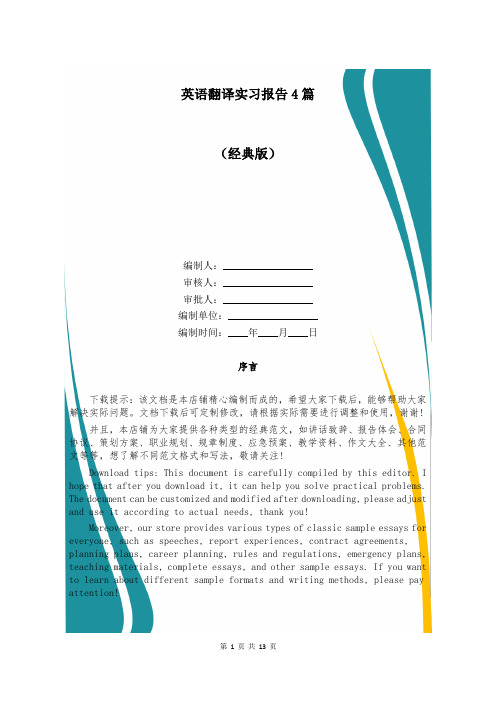
英语翻译实习报告4篇(经典版)编制人:__________________审核人:__________________审批人:__________________编制单位:__________________编制时间:____年____月____日序言下载提示:该文档是本店铺精心编制而成的,希望大家下载后,能够帮助大家解决实际问题。
文档下载后可定制修改,请根据实际需要进行调整和使用,谢谢!并且,本店铺为大家提供各种类型的经典范文,如讲话致辞、报告体会、合同协议、策划方案、职业规划、规章制度、应急预案、教学资料、作文大全、其他范文等等,想了解不同范文格式和写法,敬请关注!Download tips: This document is carefully compiled by this editor. I hope that after you download it, it can help you solve practical problems. The document can be customized and modified after downloading, please adjust and use it according to actual needs, thank you!Moreover, our store provides various types of classic sample essays for everyone, such as speeches, report experiences, contract agreements, planning plans, career planning, rules and regulations, emergency plans, teaching materials, complete essays, and other sample essays. If you want to learn about different sample formats and writing methods, please pay attention!英语翻译实习报告4篇下面是本店铺整理的英语翻译实习报告4篇(翻译实训报告英文),供大家阅读。
翻译理论与实践研究

翻译理论与实践研究翻译是语言交流和文化传承的重要方式,也是促进不同文化交流的桥梁。
翻译工作有时候需要顾及到语言的准确性、风格、语气、意境等方面,同时还需要融入历史、文化、时代背景等因素,这不仅仅是技术性的转译工作,也需要对文化的理解和诠释,这就需要翻译人员具备良好的语言素养、文化视野和专业技能。
对于翻译工作的理论和实践研究,这里就作一些探讨。
一、翻译理论对翻译实践的指导作用翻译理论是对翻译活动进行科学深入地探究和总结,旨在指导和改进翻译实践。
现代翻译理论认为翻译是一种跨越语言和文化的交际活动,因此对于翻译人员来说,不仅仅是单纯地把一种语言转化为另一种,而是需要具备文化素养和交际技巧,以更好地传递信息和理解信息。
对于翻译理论的研究,一方面可以帮助翻译人员提高翻译质量和效率,另一方面也可以为翻译教学提供指导和参考。
现代翻译理论主要分为功能翻译理论、文化翻译理论、语用翻译理论等,不同的理论强调了不同的翻译重点。
例如,功能翻译理论认为翻译的目的是达到功能目标,即“译文必须达成与译前文本相同或相近的交际效果”,因此强调翻译的准确性和自然度;文化翻译理论则认为翻译是一种文化交流和文化传承,翻译应该注重文化的传递和表现;语用翻译理论则关注的是翻译的语用效果和交际目的,强调按照社交规则、语境、交际目的、语用关系等实现译文的目的。
不同理论都有其优劣之处,对于翻译人员而言,需要结合实际情况和任务需求,选用合适的翻译理论开展工作。
二、翻译实践中的典型案例翻译实践中,适用不同的翻译理论,处理起来的任务和情境会有所不同。
例如,想象一位翻译人员在为游戏翻译进行工作时,他需要把游戏中的角色名、物品名、场景描述等信息全部翻译为目标语言,这个时候考虑到游戏文化的特殊性,可以采用文化翻译理论。
在使用文化翻译理论的过程中,译者首先要理解源文作品所蕴含的文化信息和思想,根据本源文化和目标文化之间的差异,对文化信息进行选择、替换、调整等,以便更好地传达原作的信息和精神内涵。
翻译理论与实践(全套PPT课件)
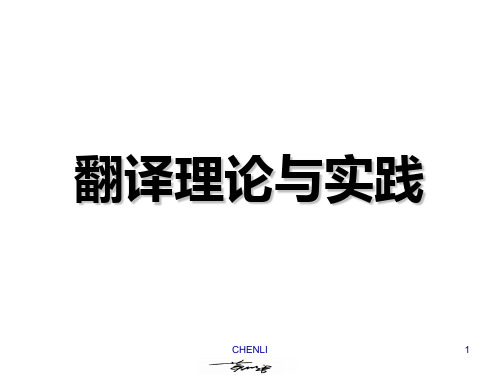
CHENLI
12
导学——课程要求
Tests: 60% There will be only one test: a final. But there may also be
several short quizzes through the term. Attendance: 20%
Daily attendance will be recorded. Each time a student will get 2.5 points. 1point for attendance, 1 point for being on time, and 0.5 point for participating in discussion and interacting positively with fellow classmates.
CHENLI
13
导学——课时安排
课时安排:
教学内容
导学 第一章:翻译概述 第二章:英汉语言对比 第三章:词语的翻译 第四章:句子翻译技巧(上) 第五章:句子翻译技巧(下) 第六章:常见文体的翻译
注:可能 因授课实际情况,课时安排会做适当调整。
CHENLI
课时 2 2 2 2 2 2 4
14
导学——学法指导
Main Language points: 1. Comparative studies of language family 2. Comparative studies of word building in English and
Chinese 3. Comparative studies of syllable
Exercise
CHENLI
5
第三章:词语的翻译
中医英语第二版课后翻译

Lesson 01II.New Words1.pathogenic致病的2.misscellaneous各式各样的;杂的3.extant现存的4.distinct 截然不同5.pivot枢轴;支点6.diagnostics诊断学7.therapeutics治疗学8.supplement录,增刊9.lore学问,知识10.synopsis大纲;要略11.etiology病因学12.pharmacopoeia 药典13.emergency紧急情况14.gynecoloy 妇科学15.obstetrics产科学16.pediatrics儿科学17.proofread校对;改正校稿18.exogenous出汗;发汗20.emesis呕吐;呕吐的行为21.purgation净肠;洗肠;通便22.remedy 疗法,补救,赔偿23.pharmacologist药物学家pendium25.astronomy天文26.anatomy 解剖学pilation汇编,编轧28.pathogenesis 发病机制29. stasis停滞30.monograph专论1、术语翻译1.traditional Chinese medicine; TCM中国医药学2. basic theory of traditional Chinese medicine中医基础理论3.clinical experience临床经验4.treatment based on syndrome differentiation辨证论治5.miscellaneous diseases杂病6.Chinese pharmacy中药学7.four properties and five tastes/flavors四气五味acupuncture and moxibustion; acumox针灸9. classical Chinese philosophy古代中国哲学10. sweating therapy; diaphoresis汗法11. purgation 下法12. vomiting therapy; emetic therapy吐法13. the School of Reinforcing the Earth补土派14. etiology 病因学15. prescription; formula方剂16. medical practice医疗实践17. therapeutic principles治疗原则18. herbs cold and cool in nature寒凉药物19. nourishing yin and reducing fire滋阴降火20. diseases caused by blood stagnation瘀血致病2、句子翻译1.TCM has a history of thousands of years and is a summary of the Chinese people's experience in their struggle against diseases.中国医药学有数千年的历史,是中国人民长期同疾病作斗争的经验总结。
理论与实践英语作文及翻译
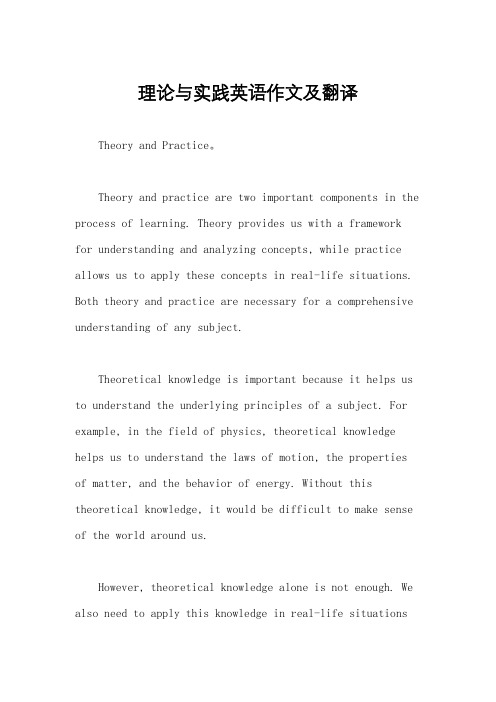
理论与实践英语作文及翻译Theory and Practice。
Theory and practice are two important components in the process of learning. Theory provides us with a frameworkfor understanding and analyzing concepts, while practice allows us to apply these concepts in real-life situations. Both theory and practice are necessary for a comprehensive understanding of any subject.Theoretical knowledge is important because it helps us to understand the underlying principles of a subject. For example, in the field of physics, theoretical knowledge helps us to understand the laws of motion, the properties of matter, and the behavior of energy. Without this theoretical knowledge, it would be difficult to make sense of the world around us.However, theoretical knowledge alone is not enough. We also need to apply this knowledge in real-life situationsin order to fully understand its implications. This is where practice comes in. Through practice, we can test our theories and see how they work in real-life situations. For example, a doctor may have a theoretical understanding of how to treat a particular illness, but it is only through practice that they can develop the skills and experience necessary to successfully treat patients.Theory and practice are also interconnected. Theoretical knowledge can inform our practice, while practice can also lead to new theoretical insights. For example, a scientist may develop a new theory based on observations made during an experiment.In conclusion, theory and practice are both essential components of learning. Theoretical knowledge provides us with a framework for understanding concepts, while practice allows us to apply this knowledge in real-life situations. By combining theory and practice, we can gain a comprehensive understanding of any subject and develop the skills and experience necessary to succeed in our chosen field.理论与实践。
